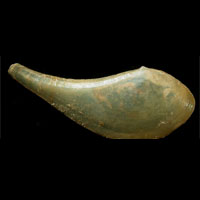|
< Previous family introduction |
|
|||||
 |
Family Nuculanidae Nut Shells |
|||||
|
Members of the Nuculanidae are primitive molluscs placed, along with the Nuculidae, in the subclass Protobranchia. Shells of this family have a taxodont hinge, but shell shape is variable from almost circular to strongly drawn out posteriorly; accordingly the species are allocated to genera based simply on shell shape. Nuculanids have inhalant and exhalant siphons posteriorly, and in some species the shell is much elongated posteriorly. Feeding is by detritus collection and suspension filtration of the water bought in through the inhalant siphon. The palp proboscides extend out beyond the shell to collect particles of food directly from the substrate and they then transport them to the mouth as for the Nuculidae, but the gills augment the food supply by collecting suspended matter from the incoming water. The animals live partly buried in the substrate with the posterior end protruding. Nuculanids vary from 4-18 mm in length and from moderately common to rare. They all occur subtidally, with only two species occurring in sufficiently shallow water to be found in beach washup. A few species occupy the zone shallower than 200 m depth, but most occur deeper, particularly in the range 300-1500 m. The family is cosmopolitan in distribution. In Australia some species are known only from NSW, which others have a southern Australia distribution. Lamprell & Healy (1998) list 25 species of Nuculanidae from Australia, 11 of which occur in NSW. The size range they provide for a number of species relates only to holotypes and hence do not necessarily reflect the actual maximum size attainable. Family References Lamprell, K. & Healy, J.M. 1998. Bivalves of Australia Volume 2. Backhuys Publishers, Leiden, Netherlands. 288 pp. Coverage All species known from NSW are detailed here. Identification Notes Shells of this family have a taxodont hinge, which is also present in the Nuculidae. The shell’s interior is not nacreous and there is a pallial sinus (the attachment scar for the siphons), although this is usually not obvious. The posterior end of the shell is longer than the anterior, and sometimes drawn out into a rostrum. |